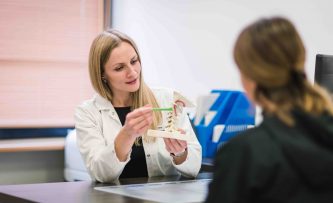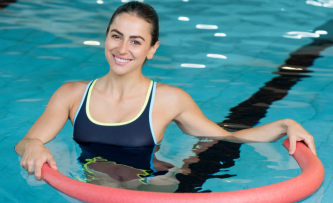Rehabilitation is an Important Factor in Minimizing the Consequences of a Stroke
It is quite common to have a relative, acquaintance or friend who has experienced a stroke. Doctors always talk about the dangers of cardiovascular diseases, discussing their causes and how to prevent them.
This time we will discuss the consequences of a stroke. It does not have to always mean that you will not be able to return to your normal life. Specialists can help persons who have suffered from a stroke and their relatives. We discuss the importance of rehabilitation in minimizing the consequences of a stroke with Lina Ališauskaitė, a physiotherapist working at “Gemma” rehabilitation centre.
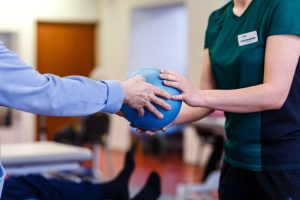
What is a brain stroke, how does it happen and what consequences can it have?
Brain stroke, or simply stroke, is one of the most common causes of morbidity and mortality in the world. A stroke can be described as a sudden disruption of the blood supply to a certain area of the brain, which occurs when the arteries supplying the brain are suddenly blocked by a blood clot.
A stroke can cause sensory and motor disturbances of the limbs. Depending on the location of the stroke in the brain, memory, speech, vision, spatial perception, reading, writing may also be impaired, a person may become depressed, indecisive and cautious. Patients require more or less assistance with self-care and some of them need constant care.
The most common consequence of a stroke due to the paresis of one side of the body, changes in balance and coordination are movement disorders. Movement usually returns within the first 3-6 months after a stroke, so rehabilitation is most effective during this period.
You mentioned rehabilitation, how can it be beneficial for the patient? What can be expected after starting the rehabilitation?
The main goal of the rehabilitation for stroke patients is to restore or compensate the damaged functions, to achieve as much independence as possible, to help them return to society, to lead a normal life and to maintain social as well as economic independence. Complex rehabilitation in our centre is carried out by a team of rehabilitation specialists. We develop an individual program for each patient, the intensity, scope and goals of which depend on the condition of the patient and degree of disability. Complex measures are applied to rehabilitation patients: medications, kinesiotherapy (1/2 times a day), occupational therapy, electrical muscle stimulation, massage, physiotherapy. Rehabilitation shall be applied in a continuous and coordinated manner while also receiving feedback from patients. It is extremely important that the patient himself/herself participates in the rehabilitation process, in which we also try to involve the relatives of the patient.
You are an experienced physiotherapist. Maybe you can tell me more about the importance of physiotherapy?
Physiotherapy is a very important part of a complex treatment and rehabilitation. The main purpose of physiotherapy is the use of movement as a natural biological factor to restore and improve body functions. When we select physiotherapy exercises, we assess not only the general condition of the patient, disorders of biosocial functions, the condition of damaged organs or systems, but also the psycho-emotional well being.
In case of a complete damage, when the patient cannot perform an active movement on his/her own, we use ideomotor training: the patient mentally performs imaginary movements with the affected limb in order for the movement pattern to be fixed in the cerebral cortex. Positional treatment, therapeutic massage and passive exercises are appointed to such patients. This is done in order to maintain the mobility of the joints, prevent bedsores, contractures and pneumonia, reduce pain, prevent deep vein thromboembolic complications and infections.
When a minimal movement appears, we then apply semi-active exercises and later – the active ones. We try to strengthen weakened muscle groups, maintain joint mobility, develop balance and apply corrective exercises in order to relax excessively tense muscles or regulate the muscle tone. A lot of attention is paid to general physical training, strengthening the cardiovascular and respiratory systems. We also apply breathing exercises, walking as well as exercises with cardio equipment.
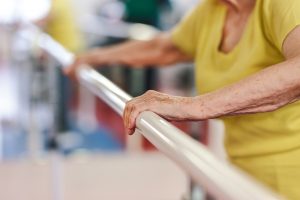
What would you like to say to patients and their families?
I would like to encourage them and emphasize that the rehabilitation has to be started as soon as possible after a stroke. Only timely and actively applied complex treatment measures improve the prognosis of the disorder, help restore damaged functions, avoid complications and enable the patient to adapt to the daily activities. Please feel free to contact and consult the specialists. It will take time, but from my experience I can say that consistent and patient work really brings good results.
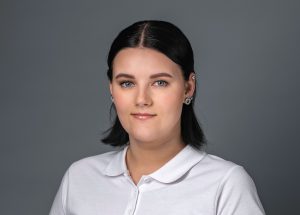
Specialization:
- Neurological, orthopaedic and traumatological physiotherapy;
- Physiotherapy of patients with respiratory and cardiovascular diseases;
- Preparation of an individual physiotherapy program;
- The use of PNF in physiotherapy practice;
- Using the McKenzie, Williams, McGill methods in physiotherapy practice;
- Use of Gymnic balls, Therabands and other tools in physiotherapy practice;
- Physiotherapy after urological and gynaecological surgeries.

 EN
EN  LT
LT  RU
RU 